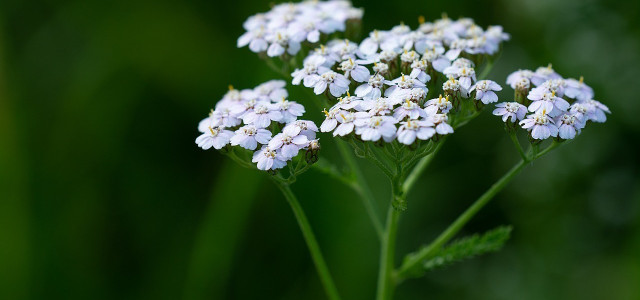Since antiquity, many of yarrow’s benefits have been well known to mankind. It has traditionally been used, for example, to treat digestive problems and to provide relief from menstrual cramps. Here’s all you need to know about yarrow’s many benefits and uses.
The yarrow plant grows all over the world. In the summer months, it can be found growing along roadsides, in fields, or even on your lawn. The dried stems and flowers have been used since ancient times to provide relief from various ailments.
The list of yarrow’s benefits and medicinal uses is long. It has been known to be effective in treating gastrointestinal tract discomfort, menstrual cramps, loss of appetite, and certain skin problems. Different yarrow benefits are administered in various ways: the constituent parts of the plant are used to make yarrow tea, tinctures, and bath additives. The list of known yarrow uses is long because yarrow is easy to administer, has very few side effects, and the young leaves and edible flowers can even be used to beatify your salads, and make them extra nutritious.
Note: Yarrow looks very similar to some poisonous herbs such as the spotted hemlock or the giant hogweed. If you want to collect yarrow yourself, you should look at the plants very carefully and ask someone who knows about herbs for a second opinion.
List of Yarrow Uses

Yarrow benefits are useful against a considerable number of afflictions and mild illnesses. The herb and flowers contain tannins, essential oils and alkaloids, and can have anti-inflammatory, antibacterial and antispasmodic effects.
Without further ado, our official list of known yarrow uses:
- Gastrointestinal: Yarrow can be used for mild gastrointestinal problems, like stomach aches, flatulence, constipation and diarrhea.
- Bile: Yarrow’s benefits also include the stimulation of bile flow, thus relieving feelings of fullness and nausea.
- Respiratory tract: Yarrow’s essential oil in particular is considered to be anti-inflammatory. If you have a cold or other upper respiratory tract discomfort, you can rub it on your chest to help activate your mucous membranes.
- Menstruation: Since yarrow has an antispasmodic and calming effect, it can help relieve menstrual pain in women, such as abdominal cramps and nausea.
- Skin: Another of yarrow’s uses is as an antibacterial agent. It is particularly effective against skin irritation, abrasions, or sunburn.
Read on: Natural Home Remedies for Colds: 6 Easy Recipes
Yarrow Benefits: How to Administer the Yarrow Plant



To alleviate symptoms, yarrow can be administered either externally, as a tincture or bath additive, or internally as yarrow tea.
However, you should be careful if you are prone to allergies or hypersensitivity to daisies or yarrow in particular. If you are pregnant or breastfeeding, you should consult your doctor before employing any of yarrow’s medicinal uses.
Here’s how to administer yarrow:
- As Yarrow Tea: Pour one cup of boiling water over two teaspoons of yarrow herb. After 10 to 15 minutes you can strain off the yarrow. You can drink the yarrow tea up to three times a day. Yarrow tea is said to be particularly effective against menstrual cramps.
- As a Bath Additive: Pour four cups of boiling water over 1/2 cup of yarrow flowers and herb. Allow to steep for 20 minutes. Afterwards, add the liquid to your bath water. One of yarrow’s benefits is that soaking in a yarrow-infused bath can alleviate digestive problems and relieve cramps.
- As a Tincture: To make a tincture, you will need 1/4 cup of yarrow herb and 1 cup of rubbing alcohol (make sure that your rubbing alcohol contains at least 70% pure alcohol). Leave both ingredients to stand for eight days and then strain them. To administer the tincture, add 20 drops to water or tea. Take up to three times a day.
- As a Compress: Pour two cups of boiling water over 2 teaspoons of yarrow herb. Let steep for five minutes, then strain. While the yarrow herb is steeping, prepare a hot water bottle. Soak a clean cotton cloth with the strained yarrow-infused water, wring it out and place it on your ribs. Place the hot water bottle over the cotton cloth. Make sure that the compress isn’t too hot. The heat should be pleasant – this will stimulate circulation and relieve cramps and other tensions in the body. Apply for 20 to 30 minutes.
This article has been translated from German to English by Christie Sacco. You can read the original here: Schafgarbe: Wirkung und Anwendung der Heilpflanze.
Important Information regarding Health-related Topics.
** Links to retailers marked with ** or underlined orange are partially partner links: If you buy here, you actively support Utopia.org, because we will receive a small part of the sales proceeds. More info.Do you like this post?






